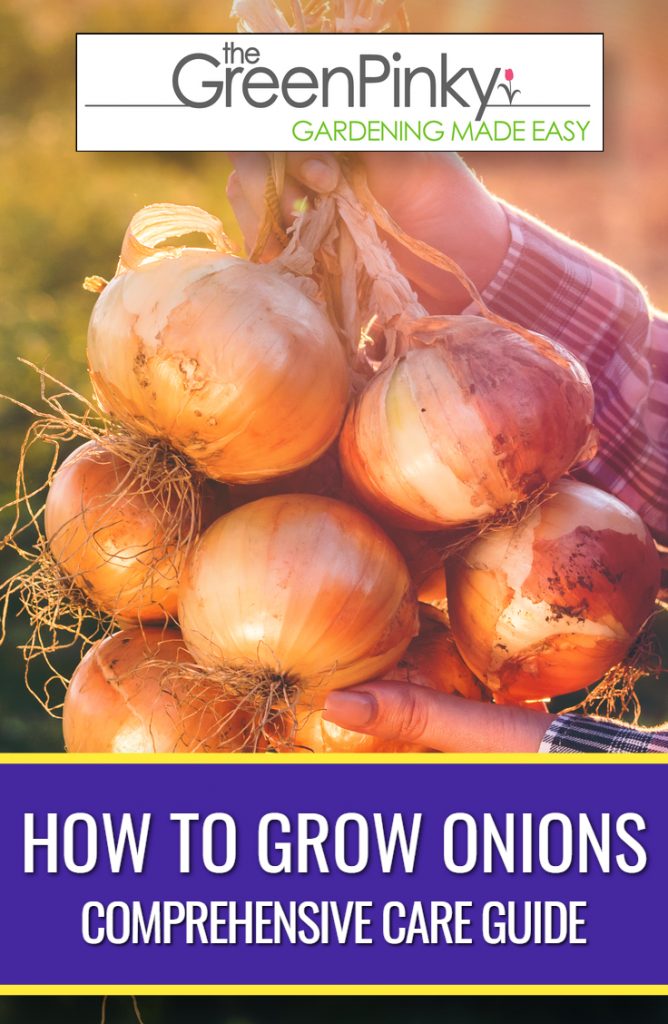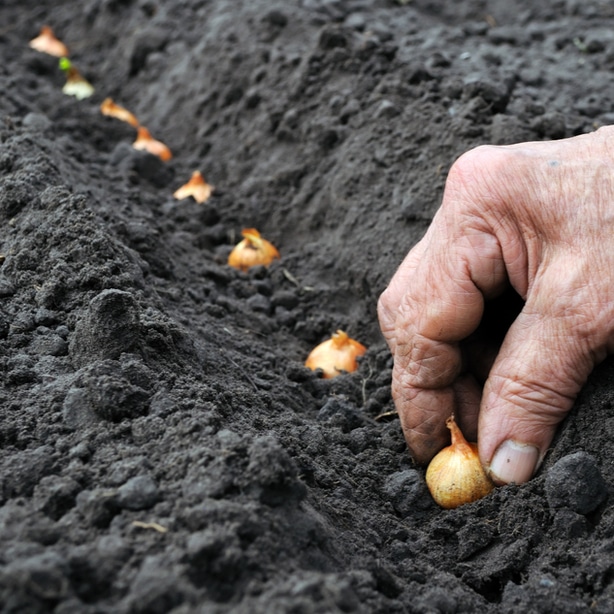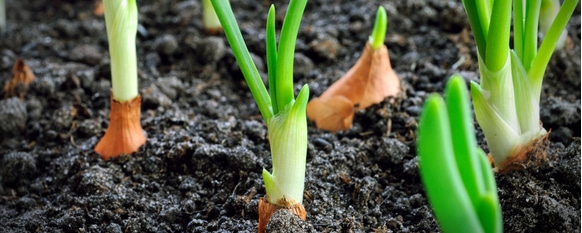Known as a cooking staple in many kitchens and chocked full of health benefits, onions make a great addition to a home garden. With our complete guide, you will be successful in growing and harvesting in no time!
Successfully growing onions in your garden entails choosing the best type for your area, deciding which growing method to employ, timing planting correctly, and following basic growing tips for sunlight, watering, fertilizing, and weeding.
If you have arborvitae in your yard, make sure that you aren’t make some of the common mistakes when you trim them. Pruning arborvitae are important to maintaining proper health.

Different Types
One of the biggest mistakes home gardeners make is planting the wrong type of onion in their garden, resulting in a disappointing harvest of small bulbs. This lackluster yield happens even if plants are cared for correctly. To ensure a fruitful growing season, understand the different types and plant one appropriate for your climate.
The different varieties are classified by the amount of sunlight it needs daily to “set” its bulbs: long-day, short-day, and day-neutral onions. Each type is better suited for certain areas of the country, making it necessary to choose your growing area’s correct variety.
Long Day Varieties
- Require 14 to 16 hours of daylight.
- Best grown in zone 6 and colder (climates north of an imaginary line drawn from Washington D.C. to San Francisco).
- Plant in late winter or early spring for a summer crop.
- Include Walla Walla, Yellow Sweet Spanish, and White Sweet Spanish varieties.
Short Day Varieties
- Require 10 to 12 hours of daylight.
- Best grown in zones 7 and warmer.
- Plant in fall for a late spring crop.
- Include Vidalia, Texas Super Sweet, Texas Sweet White, Georgie Sweet, and Sweet Red varieties.
Day Neutral Varieties
- Require 12 to 14 hours of daylight.
- Form bulbs in any of the USDA growing zones, but are best in zones 5 and 6.
- Plant in the fall in areas with mild winter climates; plant in early spring in northern climates with harsh winters.
- The most commonly grown variety is Candy Hybrid.

Different Methods to Grow
There are three very distinct ways to grow onions in your garden. You can start them from seeds, from small plant bulbs (known as sets), or from a mature bulb. Each way of planting has slightly different steps for starting plants.
Growing from Seed
Growing from seed is the most cost-effective way to start plants, especially if you already own seedlings trays. Start seeds indoors approximately 8 to 10 weeks before the last expected frost date for your growing season. Transplant the hardened seedlings to the garden two to three weeks after the last frost.
Growing from Sets
Growing from small bulbs (or sets) are a more convenient way to plant them versus starting seeds indoors. These sets are a result of planting onions in a very tight fashion and never thinning them out during the growing season. As such, they end up becoming smaller, heartier bulbs. Many gardeners prefer them over seeds since they establish quickly and are easier to plant.
Look for sets that are no bigger than three-quarters of an inch in diameter. Ones larger than this produce stiffer necks and seed too quickly.
Growing from Mature Onions
Growing from onion scraps is a fascinating and inexpensive way to start new plants. Instead of throwing away the onion bottom, you can use it to sprout new plants instead of using seeds. The sprouts can be eaten as green onions, or the transplants can be planted into the garden to form bulbs.
Timing
Onions grow best when planted at two different times of the year, depending upon your local climate. They are considered cool-season vegetables. Gardeners in northern climates, where the winters are harsh, plant in early spring for a late summer crop. Gardeners in southern climates can plant in the spring or the fall for a spring harvest.
- For spring planting, aim to transplant seedlings or plant sets in your garden beds when soil temperatures are consistently above 28℉. This is typically late March or early April.
- For fall planting, aim for planting sets in August or September, giving them six to eight weeks to grow before the fall temperatures start to fall. As temperatures dip in the winter, your plants will go dormant, and eventually resuming growing again in the spring.

Soil Prep
Onions grow best in well-drained sandy or loamy soil; heavy soils containing a lot of clay hinder bulb growth and maturation, resulting in a stunted, smaller crop. If you have heavy soil, consider amending with organic compost to help your soil retain more moisture. They prefer soil that has a pH from 5.5 to 6.5.
Similar to planting carrots, it is essential to properly prep the garden soil before planting. Since the bulbs form under the soil surface from the main root, the ground needs to be well-tilled and free of rocks or other large debris to prevent poor growth or deformities in the mature bulbs.
To prepare garden beds for planting, dig down about eight or ten inches deep, working the ground will either by hand or with a rototiller. Pick out any large rocks, trash, or other debris. Mix in several inches of finished compost or manure and work the soil well a second time.
You may also want to consider checking out our article on how to grow basil in your garden.
Plant Spacing
Space onions 4 to 6 inches apart within the rows, and space rows 12 to 18 inches apart. Spacing appropriately allows for optimal growth. Plant sets in furrows about 2 inches deep, with the point facing up, so the top ends up about one inch deep below the soil surface once covered.
Proper plant spacing is important to make sure each of your plants have access to enough sunlight, soil moisture, and plant essential nutrients. As hard as it is, follow the recommended spacing. When planted too closely together, each plant competes with neighboring plants; as a result, none of the onions may receive the resources needed for optimal growth.

Growing Tips
Many gardeners have been hesitant to plant onions in their garden rotation because of age-old rumors that they are finicky to grow. Rest assured, though, this isn’t the case if you understand and follow some basic growing tips.
A good crop needs adequate sunlight, consistent water, regular fertilizer applications, and proper weed management.
Sunlight Requirements
Like many other garden vegetables, onions grow best in garden spots classified as full sun locations. This means they receive a minimum of six hours of sunlight daily. If full sun spots are limited, you can plant them in partial shade. They tolerate partial shade, but you may see a reduction in growth and yield.
Watering Frequency
Onion roots stay short, making the plant inefficient at pulling water from the soil. While plant growth slows during drought periods and resumes again once watered, it’s best to keep the soil consistently moist until the bulbs are fully mature. Water them so that they receive about one to two inches of water weekly.
Fertilizing
Onions are considered moderate to heavy feeders and prefer a balanced fertilizer containing similar nitrogen, phosphorus, and potassium values. Unlike other crops that form below the soil surface, they need more nitrogen fertilizer to promote foliage growth. Each leaf that grows forms a ring on the bulb. More leaves mean larger bulbs with more rings.
- Once your plant has five to six leaves, start fertilizing regularly to promote larger plants and bigger bulbs.
- Fertilizer every two weeks throughout the growing season until the bulbs begin to form, making sure to water the fertilizer into the soil well.
- Stop fertilizing when the bulbing process causes the onions to push the soil away and “pop” up out of the ground.
Weeding
Weeds compete with neighboring plants for resources, similar to how plants too close together compete.
To prevent competition, frequently remove weeds by hand when you find them sprouting around your onions, especially when your plants are young and establishing. If possible, avoid using a hoe to weed; chopping too deeply into the soil risks damaging the bulbs.

When to Harvest
One of the advantages of planting onions in your garden is the versatility the plants offer. They can be harvested when they are small for green onions or allowed to grow larger for dry-bulb onions. When you schedule your harvest depends entirely upon your culinary needs and how you plan to use the bulbs.
- If you are growing for use as green onions, harvest them once they reach pencil-sized. Green onions are harvestable up until they start forming bulbs.
- If you are growing for the larger, dry bulbs, let the plants grow larger, so bulbs form to the desired size. For many varieties, this takes 3 to 4 months from the time of planting. They are ready to harvest when the main stem weakens and falls over.
When harvesting, grab the green tops firmly in your hand, just above the soil. Pull the the bulb straight up out of the ground. If necessary, use a small garden spade or trowel to loosen the soil around the bulbs, but make sure not to damage the bulb.
Companion Plants
Onions can make excellent companions to certain fruits, veggies, and herb plants that you may already grow in your garden. The volatile compounds found in many Allium species naturally repel pesky garden insects such as aphids, acting as a biological preventative. Onion plants are also thought to improve the flavor of some neighbors.
Common companion plants include:
- Chamomile
- Summer savory
- Dill
- Beets
- Broccoli
- Brussels sprouts
- Cabbage
- Cauliflower
- Kohlrabi
- Leeks
- Lettuce
- Peppers
- Strawberries
- Tomatoes
It is recommended to avoid planting onions next to asparagus, beans, peas, and sage; there may be a chemical incompatibility between the plants and possible flavor contamination. You should also keep onions away from closely related family members such as garlic, leeks, and shallots as they all attract the same insect pests.

